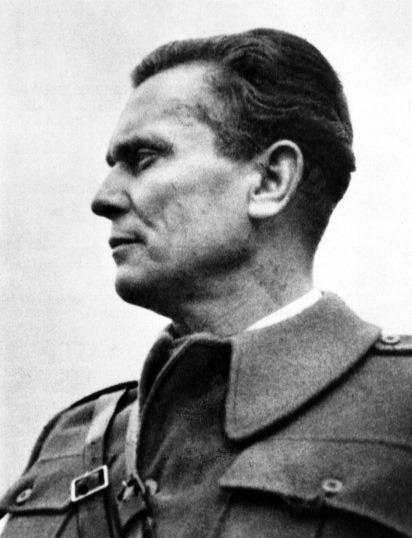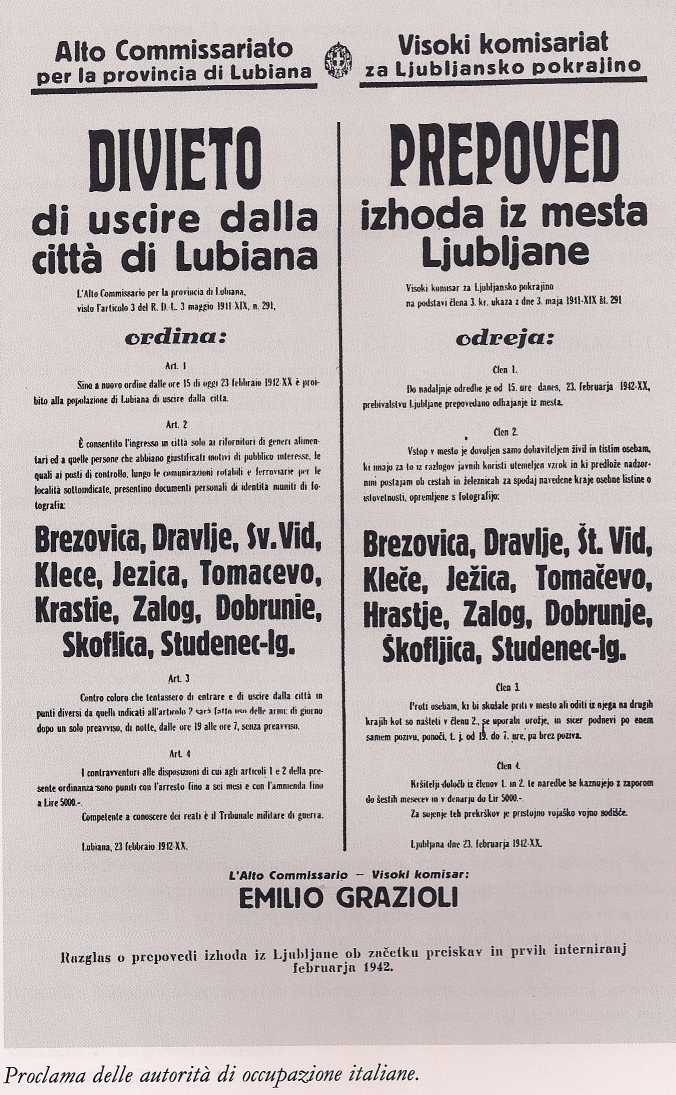|
Slovene National Liberation Council
The Slovene National Liberation Committee (SNOS) ( sl, Slovenski narodnoosvobodilni svet; sh, Slovensko narodnooslobodilačko vijeće, Словеначко народноослободилачко веће) was formed as the highest governing organ of anti-fascist movement of Slovenes during World War II. The president of its presidium was Josip Vidmar. SNOS was formed on February 19, 1944 in Črnomelj when the 120-member Liberation Front Plenum, constituted in 1943 by the Assembly of the Delegates of the Slovene Nation in Kočevje, opted to change its name to SNOS and proclaim itself as the temporary Slovenian Parliament. One of its most important decisions was that after the end of the war Slovenia would become a state within the Socialist Federative Republic of Yugoslavia. In spite of the fact the territory was occupied by Axis forces, SNOS was more than just a symbolic entity. Several important institutions functioned under its supervision. For example, it established even a S ... [...More Info...] [...Related Items...] OR: [Wikipedia] [Google] [Baidu] |
Anti-fascist
Anti-fascism is a political movement in opposition to fascist ideologies, groups and individuals. Beginning in European countries in the 1920s, it was at its most significant shortly before and during World War II, where the Axis powers were opposed by many countries forming the Allies of World War II and dozens of resistance movements worldwide. Anti-fascism has been an element of movements across the political spectrum and holding many different political positions such as anarchism, communism, pacifism, republicanism, social democracy, socialism and syndicalism as well as centrist, conservative, liberal and nationalist viewpoints. Fascism, a far-right ultra-nationalistic ideology best known for its use by the Italian Fascists and the Nazis, became prominent beginning in the 1910s while organization against fascism began around 1920. Fascism became the state ideology of Italy in 1922 and of Germany in 1933, spurring a large increase in anti-fascist action, including German ... [...More Info...] [...Related Items...] OR: [Wikipedia] [Google] [Baidu] |
Julian March
Venezia Giulia, traditionally called Julian March (Serbo-Croatian, Slovene: ''Julijska krajina'') or Julian Venetia ( it, Venezia Giulia; vec, Venesia Julia; fur, Vignesie Julie; german: Julisch Venetien) is an area of southeastern Europe which is currently divided among Croatia, Italy, and Slovenia.''Contemporary History on Trial: Europe Since 1989 and the Role of the Expert Historian'' by Harriet Jones, Kjell Ostberg, Nico Randeraad p. 155 The term was coined in 1863 by the Italian |
Political History Of Slovenia
Politics (from , ) is the set of activities that are associated with making decisions in groups, or other forms of power relations among individuals, such as the distribution of resources or status. The branch of social science that studies politics and government is referred to as political science. It may be used positively in the context of a "political solution" which is compromising and nonviolent, or descriptively as "the art or science of government", but also often carries a negative connotation.. The concept has been defined in various ways, and different approaches have fundamentally differing views on whether it should be used extensively or limitedly, empirically or normatively, and on whether conflict or co-operation is more essential to it. A variety of methods are deployed in politics, which include promoting one's own political views among people, negotiation with other political subjects, making laws, and exercising internal and external force, including wa ... [...More Info...] [...Related Items...] OR: [Wikipedia] [Google] [Baidu] |
Eastern European World War II Resistance Movements
Eastern may refer to: Transportation *China Eastern Airlines, a current Chinese airline based in Shanghai *Eastern Air, former name of Zambia Skyways *Eastern Air Lines, a defunct American airline that operated from 1926 to 1991 *Eastern Air Lines (2015), an American airline that began operations in 2015 *Eastern Airlines, LLC, previously Dynamic International Airways, a U.S. airline founded in 2010 *Eastern Airways, an English/British regional airline *Eastern Provincial Airways, a defunct Canadian airline that operated from 1949 to 1986 *Eastern Railway (other), various railroads * Eastern Avenue (other), various roads *Eastern Parkway (other), various parkways *Eastern Freeway, Melbourne, Australia *Eastern Freeway Mumbai, Mumbai, India *, a cargo liner in service 1946-65 Education *Eastern University (other) * Eastern College (other) Other uses * Eastern Broadcasting Limited, former name of Maritime Broadcasting System, Canada ... [...More Info...] [...Related Items...] OR: [Wikipedia] [Google] [Baidu] |
Slovenia In World War II
World War II in the Slovene Lands started in April 1941 and lasted until May 1945. The Slovene Lands were in a unique situation during World War II in Europe, with only Greece also sharing its experience of being trisected; however, Drava Banovina (roughly today's Slovenia) was the only region that experienced a further step — absorption and annexation into neighboring Nazi Germany, Fascist Italy, and Hungary. The Slovene-settled territory was divided largely between Nazi Germany and the Kingdom of Italy, with smaller territories occupied and annexed by Hungary and the Independent State of Croatia. Occupation, resistance, collaboration, civil war, and post-war killings On 6 April 1941, Yugoslavia was invaded by the Axis Powers. On that day, part of the Slovene-settled territory was occupied by Nazi Germany. On 11 April 1941, further parts of the territory were occupied by Italy and Hungary. The Germans occupied the Upper Carniola, the Lower Styria, the northwestern part of ... [...More Info...] [...Related Items...] OR: [Wikipedia] [Google] [Baidu] |
Anti-fascism In Yugoslavia
Anti-fascism is a political movement in opposition to fascist ideologies, groups and individuals. Beginning in European countries in the 1920s, it was at its most significant shortly before and during World War II, where the Axis powers were opposed by many countries forming the Allies of World War II and dozens of resistance movements worldwide. Anti-fascism has been an element of movements across the political spectrum and holding many different political positions such as anarchism, communism, pacifism, republicanism, social democracy, socialism and syndicalism as well as centrist, conservative, liberal and nationalist viewpoints. Fascism, a far-right ultra-nationalistic ideology best known for its use by the Italian Fascists and the Nazis, became prominent beginning in the 1910s while organization against fascism began around 1920. Fascism became the state ideology of Italy in 1922 and of Germany in 1933, spurring a large increase in anti-fascist action, including German ... [...More Info...] [...Related Items...] OR: [Wikipedia] [Google] [Baidu] |
Slovene Resistance
Slovene or Slovenian may refer to: * Something of, from, or related to Slovenia, a country in Central Europe * Slovene language, a South Slavic language mainly spoken in Slovenia * Slovenes, an ethno-linguistic group mainly living in Slovenia * Slavic peoples, an Indo-European ethno-linguistic group * Ilmen Slavs, the northernmost tribe of the Early East Slavs {{Disambiguation Language and nationality disambiguation pages ... [...More Info...] [...Related Items...] OR: [Wikipedia] [Google] [Baidu] |
People's Liberation War Of Yugoslavia
World War II in the Kingdom of Yugoslavia began on 6 April 1941, when the country was Invasion of Yugoslavia, swiftly conquered by Axis powers, Axis forces and partitioned between Nazi Germany, Germany, Kingdom of Italy, Italy, Kingdom of Hungary (1920–1946), Hungary, Kingdom of Bulgaria, Bulgaria and their Client state, client regimes. Shortly after Operation Barbarossa, Germany attacked the USSR on 22 June 1941, the League of Communists of Yugoslavia, communist-led republican Yugoslav Partisans, on orders from Moscow, launched a guerrilla liberation war fighting against the Axis forces and their locally established Puppet state, puppet regimes, including the Axis-allied Independent State of Croatia (NDH) and the Government of National Salvation in the Territory of the Military Commander in Serbia, German-occupied territory of Serbia. This was dubbed the National Liberation War and Socialist Revolution in post-war Yugoslav communist historiography. Simultaneously, a multi-sid ... [...More Info...] [...Related Items...] OR: [Wikipedia] [Google] [Baidu] |
AVNOJ
The Anti-Fascist Council for the National Liberation of Yugoslavia,, mk, Антифашистичко собрание за народно ослободување на Југославија commonly abbreviated as the AVNOJ, was a deliberative and legislative body that was established in Bihać, Yugoslavia, in November 1942. It was established by Josip Broz Tito, the leader of the Yugoslav Partisans, an armed resistance movement led by the Communist Party of Yugoslavia to resist the Axis occupation of the country during World War II. The AVNOJ reconvened in Jajce in 1943 and in Belgrade in 1945, shortly after the war in Europe ended. Between the sessions, it operated through its presidency, its executive council, and the National Committee for the Liberation of Yugoslavia. The committee was granted authority normally wielded by cabinets. While Tito presided over the committee, the AVNOJ sessions and its presidency were chaired by Ivan Ribar. The second session of the AVNOJ ... [...More Info...] [...Related Items...] OR: [Wikipedia] [Google] [Baidu] |
Communist Party Of Slovenia
The League of Communists of Slovenia ( sl, Zveza komunistov Slovenije, ZKS; sh, Savez komunista Slovenije) was the Slovenian branch of the League of Communists of Yugoslavia, the sole legal party of Yugoslavia from 1945 to 1989. It was established in April 1937 as the Communist Party of Slovenia, as the first autonomous sub-national branch of the Yugoslav Communist Party. Its initial autonomy was further amplified with the Yugoslav constitution of 1974, which devolved greater power to the various republic level branches. History In 1989 Slovenia passed amendments to its constitution that asserted its sovereignty over the federation, its right to secede and set foundations to a multi-party system. These amendments were bitterly opposed by the leadership of Serbia under Slobodan Milošević. On 23 January 1990, the Slovene delegation, headed by Milan Kučan, left the Party Congress of the League of Communists of Yugoslavia, leading to the collapse of the all-Yugoslav party. On 4 ... [...More Info...] [...Related Items...] OR: [Wikipedia] [Google] [Baidu] |
Slovene Partisans
The Slovene Partisans, formally the National Liberation Army and Partisan Detachments of Slovenia, (NOV in POS) were part of Europe's most effective anti-Nazi resistance movement Jeffreys-Jones, R. (2013): ''In Spies We Trust: The Story of Western Intelligence'', Oxford University Press, p. 87/ref>Adams, Simon (2005): ''The Balkans'', Black Rabbit Books, p. 1981/ref> led by Yugoslav revolutionary communists during World War II, the Yugoslav Partisans. Since a quarter of Slovene ethnic territory and approximately 327,000 out of total population of 1.3Lipušček, U. (2012) ''Sacro egoismo: Slovenci v krempljih tajnega londonskega pakta 1915'', Cankarjeva založba, Ljubljana. million Slovenes were subjected to forced ItalianizationCresciani, Gianfranco (2004Clash of civilisations, Italian Historical Society Journal, Vol.12, No.2, p.4 since the end of the First World War, the objective of the movement was the establishment of the state of Slovenes that would include the majority of Sl ... [...More Info...] [...Related Items...] OR: [Wikipedia] [Google] [Baidu] |
Province Of Ljubljana
The Province of Ljubljana ( it, Provincia di Lubiana, sl, Ljubljanska pokrajina, german: Provinz Laibach) was the central-southern area of Slovenia. In 1941, it was annexed by Fascist Italy, and after 1943 occupied by Nazi Germany. Created on May 3, 1941, it was abolished on May 9, 1945, when the Slovene Partisans and partisans from other parts of Yugoslavia liberated it from the Nazi Operational Zone of the Adriatic Littoral. Its administrative centre was Ljubljana. Background During World War II, Drava Banovina was in a unique situation. While Greece shared its experience of being trisected, this territory (roughly present-day Slovenia) experienced a further step—absorption and annexation into neighboring Nazi Germany, Fascist Italy, and Hungary.Gregor Joseph Kranjc (2013To Walk with the Devil University of Toronto Press, Scholarly Publishing Division, p. introduction 5 After Yugoslavia was invaded by Axis Powers on 6 April 1941, Germany and Hungary occupied and annexed the ... [...More Info...] [...Related Items...] OR: [Wikipedia] [Google] [Baidu] |


.jpg)


